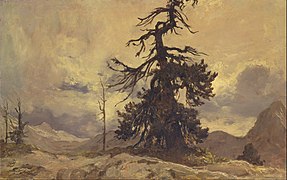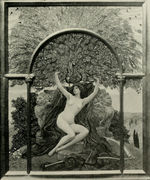Hubert von Herkomer

Sir Hubert von Herkomer
Early life and education
Herkomer was born on 26 May 1849 at Waal, in the Kingdom of Bavaria, the son of Lorenz Herkomer (1825–1888), a wood-carver of great ability, and his wife Josephine Niggl. His family was poor, and his mother tried to supplement his father's earnings by giving music lessons. Once his mother gave him a half sovereign for some shopping: "It was the last piece of gold in the place. I lost it. My parents were in despair."[1]
Lorenz Herkomer left Bavaria in 1851 with his wife and child for the United States, settling in
While in Southampton, Herkomer went to the school of art there and began his formal art training. An uncle in the United States commissioned his father to carve the Four Evangelists in wood. Receiving some money, his father determined to take Hubert to Munich, so that he could study art there while his father worked on the carvings. In his Chums interview thirty years later, Herkomer recalled the trip vividly: "Ah, how I remember that first visit to Germany! ... We crossed to Antwerp in a cattle boat ... And never shall I forget the miseries of that voyage. And then there were the railway carriages on the other side. We were compelled to travel fourth-class, in the company of people who were no less filthy than the carriages; and I remember..... I swore a big oath that if ever I had any money I would travel in the most luxurious style possible. I have never forgotten that oath". Herkomer and his father led a hard life while in Munich, but he stated that "they were very happy days" and his father sat as model for him during that time.[1]
In 1866, Herkomer began a more serious course of study at the South Kensington Schools.[3]
Career
In 1869 Herkomer exhibited for the first time at the
On 10 January 1872, Herkomer was naturalized as a British subject. Then aged 22 and living at 32, Smith Street, Chelsea, he was described as an unmarried artist. His oath of allegiance to Queen Victoria was witnessed by Sir Sills John Gibbons, Lord Mayor of London.[4]
In 1873, Herkomer visited a friend who lived in Bushey, Hertfordshire, and the next year he rented a pair of cottages there called Dyreham and a studio near Melbourne Road, Bushey. By the time he was twenty-four, he had sold a painting for five hundred pounds.[citation needed] It was by his oil painting The Last Muster (1875), after a wood-engraving of 1871, that he established his position as an artist of high distinction at the Royal Academy. Another early notable work is his Eventide: A Scene in the Westminster Union (1878). In 1879 he was elected an associate of the Royal Academy.[3]

In 1884, a full-page caricature of Herkomer by FG (his friend Franz Goedecker) appeared in Vanity Fair, captioned "Painter, Sculptor, Blacksmith &c".[5] In the same year, he established an Art School at Bushey which he continued until 1904, attracting many students. In 1885 he was appointed Slade Professor of Fine Art at the University of Oxford, a position he held until 1894. He was the first president of the Oxford Art Society, established in 1891.[6]
In 1890 Herkomer was elected a Royal Academician, in 1893 an associate of the Royal Watercolour Society, and the next year a full member.[3]
At Bushey, Herkomer built a large house, Lululaund, named after Lulu Griffith, the second of his three wives, in a heavily German style, designed about 1886 by the American architect Henry Hobson Richardson, for whom he painted a portrait. This house was completed in 1894 and thereafter served as studio and school. It contained a theatre, where Herkomer put on productions of his own plays and musical compositions and also made films.[3]
In 1899,
On her deathbed, in 1901, Queen Victoria was initially photographed in study and eventually painted by Herkomer as an alternative to the more traditional mask produced in wax, which her son, the new king Edward VII, decried. The painting, showing the Queen lying half-length among lilies and other flowers, swathed in white tulle, her right hand holding a cross, is part of the Royal Collection held at Osborne House on the Isle of Wight, where it hangs in the Pavilion Principal Stairs Vestibule. In 1907, Herkomer was knighted by King Edward VII.[3]
Herkomer exhibited a large number of memorable portraits, figure subjects, and landscapes, both in oil and
Despite being a prominent member of
Four of his pictures, Found (1885), Sir Henry Tate (1897), Portrait of Lady Tate (1899) and The Council of the Royal Academy (1908), are in the national collection at the
Herkomer was also a pioneering filmmaker. He established a studio at Lululaund and directed some seven historical costume dramas designed to be shown accompanied by his own music. None of them is known to have survived.[3]
Herkomer had strong connections with
Personal life
In 1873, at Watford, Herkomer married Anna Caroline Ada Weise. A son, Siegfried Hubert, was born in 1875 and a daughter, Elsa Anna Iole, the next year. His first wife died in Vienna in 1883. In 1884, Herkomer married Eliza Louisa Griffiths, aged 35, known as Lulu, at Ruthin. She died a year later in child-birth. He then married a third wife, Maggie Griffiths, the sister of Lulu, also from Ruthin. [3]
In 1888, Herkomer's father, Lorenz Herkomer, died at Watford aged 73. The next year, Herkomer's third wife gave birth to a son who was named Lorenz Hans Lawrence. In 1893, they had a daughter, Gwenddydd.[3]
Death and legacy
Herkomer died at Budleigh Salterton on 31 March 1914 and was buried in St James's church, Bushey.[3]
Paintings by Herkomer are in several British collections, including the
Among his pupils at the Herkomer School of Art in Bushey were many artists who later became notable in their own right, including Cecil Jay and Beryl Fowler.[12][13]
Heekomer's connection with the 1896 Eisteddfod is commemorated in the naming of Herkomer Crescent and Herkomer Road, Llandudno.
Gallery
-
The Last Muster (1875)
-
Eventide: A Scene in the Westminster Union (1878; Walker Art Gallery, Liverpool)
-
The Dying Monarch, Funtensee, 1884
-
Hard Times (1885; Manchester Art Gallery)
-
Portrait of Henry Hobson Richardson (1886)
-
On Strike (circa 1891)
-
Poster for the rally initiated by Herkomer (1907).
-
A Guard-Room at Aldershot (1870)
-
Sunday at the Chelsea Hospital (1871).
-
The 'Schuhplattl' Dance (1873)
-
Beauty's Altar, 1900
Writings
- Art Tuition, (Peacock, Printer, 1882; p19) – lecture in Birmingham Town Hall, on February 10, 1882.
- The Pictorial Music Play. (Magazine of Art, July 1889, pp. 316–24).[14]
- Scenic Art. (Magazine of Art, July 1889, pp. 316–24).[14]
- From Handel to Hallé. Biographical Sketches by Louis Engel. With Autobiographies of Prof. Huxley and Prof. Herkomer.(London: Swan Sonnenschein & Co., 1890),pp.135-225.
- Autobiography of Hubert Herkomer (Printed for private circulation, 1890, p71).
- Etching and Mezzotint Engraving (London: Macmillan, 1892, p107).
- A new Black and White Art, 1896, p58.
- A certain phase of lithography (London: Macmillan, 1910, p38) – a lecture in Lululaund, for invited guests, on January 27, 1910.
- My School and my Gospel (London : A. Constable and Co. Ltd., 1908).[15]
- The Herkomers. Vol. 1. (London: Macmillan, 1910).
- The Herkomers. Vol. 2. (London: Macmillan, 1911).[15]
References
- ^ a b c d Chums annual, 1896, p. 279
- ^ 1861 United Kingdom census, "Windsor Terrace, Southampton" ancestry.co.uk, accessed 13 May 2023 (subscription required)
- ^ a b c d e f g h i j k l m n o Mike W. Bucknole, Hubert Herkomer, his Life, his School and later achievements (Southampton Solent University, thesis, 2000–2010)
- ^ Certificate of Naturalization to an Alien, Hubert Herkomer, ancestry.com, accessed 14 November 2021 (subscription required)
- ^ Vanity Fair, January 26, 1884
- ^ "Oxford Art Society get ready to showcase local talent". LivinginOxford.com. Retrieved 18 October 2020.
- ^ a b One or more of the preceding sentences incorporates text from a publication now in the public domain: Chisholm, Hugh, ed. (1911). "Herkomer, Sir Hubert von". Encyclopædia Britannica. Vol. 13 (11th ed.). Cambridge University Press. p. 364.
- ^ Morgan, Sion (4 August 2014). "Archdruid calls for peace in 'Wales, Europe and the entire world' at National Eisteddfod". Walesonline.co.uk. Retrieved 29 January 2018.
- ^ "The Grand Sword | National Museum Wales". Archived from the original on 7 March 2016. Retrieved 7 March 2016.
- ^ Jan Morris, The Matter of Wales: Epic Views of a Small Country (Oxford University Press 1984), p. 155
- ^ Hubert von Herkomer, BBC, accessed August 2011
- ^ "Watercolors on Ivory by Cecil Jay (Mrs. George Hitchcock) – Indianapolis Museum of Art". Imamuseum.org. Retrieved 1 March 2016.
- ^ "Bushey Artists", Bushey Museum & Art Gallery, undated, accessed 13 May 2023
- ^ a b Quoted by Uta Grund, Zwischen den Künsten (Revised thesis, doctoral, Berlin 1999, p243).
- ^ a b Note: PDF-versions are facsimiles and are complete. So-called "Full Text" (*.txt)-Versions from same sources are not, missing dozens of pages, as of 20090214.
Further reading
- Baldry, A. L. Hubert von Herkomer, R.A., a Study and a Biography (London: G. Bell, 1901).
- Courtney, W. L. Professor Hubert Herkomer, Royal Academician, His Life and Work, (London, Art journal Office, 1892).
- Bucknole, Mike W. Southampton School and College of Art: a celebration of 150 years of artistic success, Southampton Solent University (2005).
- Bucknole, Mike W. Sir Hubert von Herkomer, CVO, RA (1849–1914), His Southampton life and early influences The British Art Journal, Volume VII, No.1 (Spring/Summer 2006), pp. 72–79.
- Bucknole, Mike W. All Roads Lead to London…or elsewhere: the Southampton School of Art, 1855–1984 Miles Taylor (ed.) SOUTHAMPTON Gateway To The British Empire, I.B. Tauris (London 2007), pp. 48–64.
- Bucknole, Mike W., Hubert Herkomers' Roses – A journey of discovery to investigate provenance (New York 2008), My Publisher. Com.
- Fenwick, Simon, 'Herkomer v Waterlow: The Presidential Election of the Royal Society of Painters in Watercolours', The British Art Journal, Volume III, No.3, Autumn 2002, pp. 48–51.
External links
- 207 artworks by or after Hubert von Herkomer at the Art UK site
- Bushey Museum and their Herkomer collection
- Herkomer biographical information
- Phryne's list of paintings by Herkomer in accessible collections in the UK
- Descriptive catalogue of portraits, etchings and engravings by Hubert von Herkomer
- Sir Hubert von Herkomer at Library of Congress, with 17 library catalogue records













